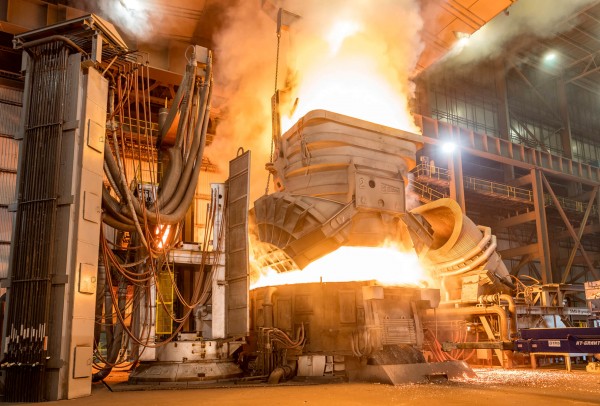But bearish industry sentiments expressed by some US experts
Nucor Corp. announced plans in January to build a new steel plate mill in the United States Midwest. Nucor’s board approved an investment of $1.35 billion to build the mill, which is expected to be fully operational in 2022 and capable of producing 1.2 million tons a year of steel plate products. The company plans on announcing the site for the new project in the coming weeks.
“By building this state-of-the-art plate mill in the Midwest,” said Leon Topalian, Nucor’s executive vice president of beam and plate products, “we will enhance our ability to serve our customers in the region while also furthering our goal of meeting all the steel needs of our customers around the country.”
The move comes on the heels of a Nucor announcement in September 2018 that it would invest $650 million to expand the production capability of the company’s flat-rolled sheet steel mill located in Ghent, Kentucky, and $176 million to construct a new hot band continuous pickle galvanizing line at the same location. U.S. Steel and Big River Steel also announced expansions to existing plant capacity last year.
Meanwhile, construction on the first new steel plant in Europe in 40 years began in April 2018. Voestalpine announced the startup of new high-tech and fully digitized forge in Kapfenberg, Austria, with an investment of some 350 million euros. The plant, still under construction, began production in October 2018.

But a January 14, 2019, report in The New York Times paints a less-than-rosy picture of the steel industry in the United States. Domestic prices for hot-rolled coil steel spiked by 40% during the first half of 2018, according to the report, in reaction to Trump administration tariffs on imported steel, only to fall over 20% during the second half of the year. Flagging demand, due to higher end prices and slowing production and investments by steel users, caused prices to crater. Employment in the sector has remained stagnant, as steel producers rely more on automation for production. Share prices for many steel companies plummeted in recent months and the consensus among the Times experts was for a bearish 2019 for the steel sector.
Ferriola disagrees with that assessment, saying that the company’s investments are part “of our planned strategy for long-term profitable growth” and that they increase “our presence in the important Midwest market, specifically in the automotive, agriculture, heavy equipment, and energy pipe and tube sectors.” Nucor’s shares fell by 18 percent in 2018, a moderate correction compared to the hammering received by some other steel shares.
Nucor’s Kentucky investments will expand the production capability of the Nucor Steel Gallatin plant in Ghent from 1.6 million tons to three-million tons annually and will also increase the maximum coil width produced. The pickle galvanizing line is expected to be operational within the next few months and will produce 500,000 tons per year of galvanized hot band steel. Ferriola said Nucor is evaluating additional expansion projects as part of the company’s initiative to grow its sheet business.
U. S. Steel announced in August that it would invest $750 million to modernize and enhance its Gary Works plant in Indiana. In June, Big River Steel announced that it is expanding its Arkansas-based scrap recycling and steel production facility, doubling the company’s hot-rolled steel production capacity to 3.3 million tons annually and facilitating the company’s ability to produce higher grades of the electrical steel used in energy efficiency products and in hybrid and electric vehicles.
Europe’s First New Steel Plant in 40-years
Europe’s first new steel plant in 40 years will be fully digitalized, according to the global, Vienna-based Voestalpine Group, which generated revenues of over 13 billion euros during its 2017/2018 fiscal year. Beginning in 2021, the new plant will produce over 200,000 tons of high-performance steels annually, chiefly for the aerospace and automotive industry as well as the oil and gas sector.
The new steel plant will replace an existing Voestalpine plant in Kapfenberg and will produce pre-materials for the aerospace, 3D-printing, automotive, and oil and gas extraction industries. The company’s aerospace customers include Airbus, Boeing, Embraer, and Bombardier, which use Voestalpine products in structural and undercarriage parts, engine components, and door segments. The new plant will process material produced by Voestalpine’s specialty steel plant.
Voestalpine CEO Wolfgang Eder claimed the plant startup is “a positive signal for European industry, as this is the first investment in a completely new steel plant in decades.” By 2021, he added, Voestalpine will have invested half a billion euros in technology development and digital transformation at the site in Kapfenberg.
According to The New York Times report, the U.S. steel industry over the last 40 years has received—as it is now—substantial levels of trade protection. The problem, according to one expert, is that during these periods of protection, U.S. steel companies usually don’t make investments that promote efficiency and competitiveness.
Perhaps Nucor is the exception to that rule. But given plummeting demand and prices, the best bet for the steel industry as a whole might be for the U.S. government to embark on a major infrastructure initiative, a program that has been spoken about for years but which has not yet materialized. A one-thousand mile southern border wall made of steel slats, as once suggested by President Donald Trump, might also boost demand for steel-industry products.
Unfortunately, given the current partisan gridlock in Washington, it is highly unlikely that either such project will come about any time in the near future.




